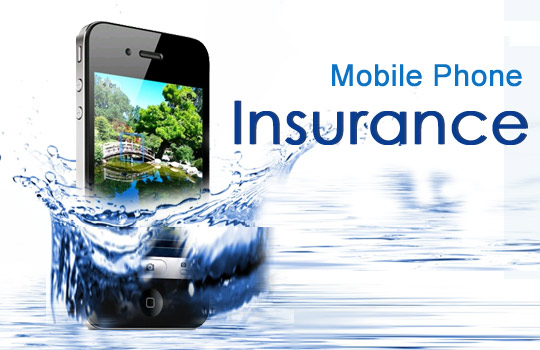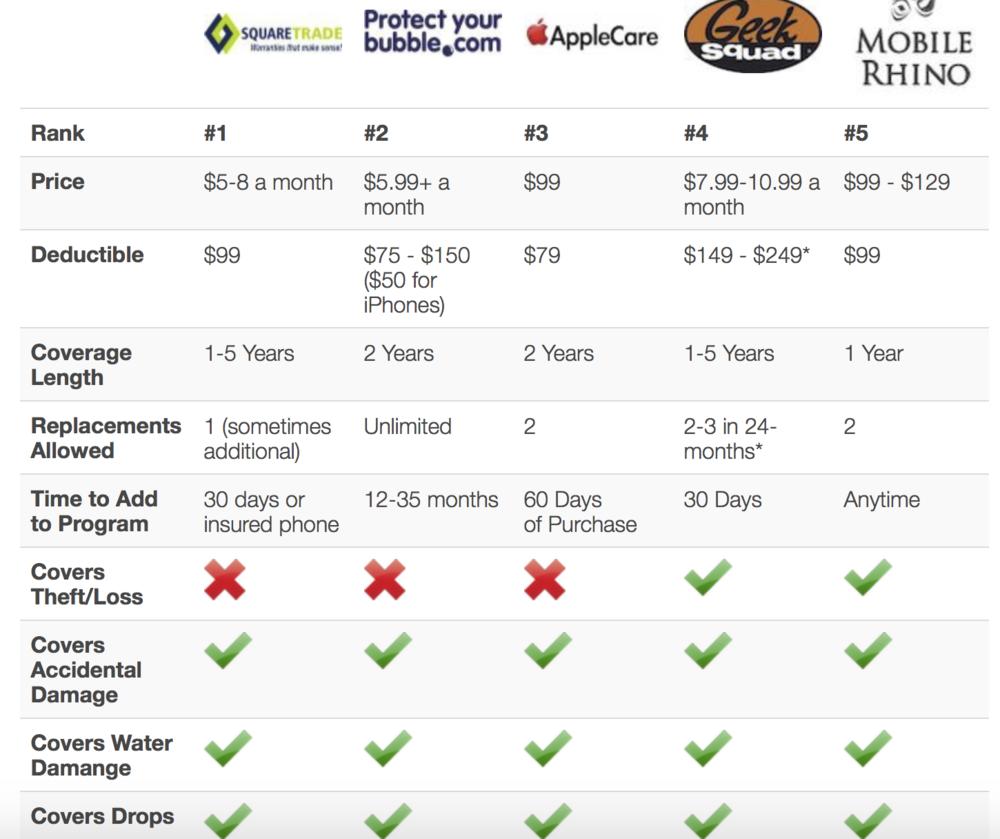Warranty vs Insurance and what it means for you
When purchasing smartphones and mobile devices such as iPhones, Androids, Galaxies and tablets the most common question that comes up; typically from a sales rep at your carrier store is: "Would you like insurance for the device?"
Often times we see confusion around what a warranty is, what insurance is and even extended warranty and what they do and don't cover.

Warranty
A warranty is "contract" or claim between the consumer and the manufacturer that the purchased product from said manufacturer will be free of defects in materials and workmanship or it will be replaced within a period of time. Most manufacturers offer a 1 year (12-months) [limited] Warranty which vary according to jurisdiction, but commonly new goods are sold with implied warranty that the goods are as advertised.
A warranty is typically free and included with a the sale of a new product from an authorized vendor.
"In the United States, various laws apply, including provisions in the Uniform Commercial Code which provide for implied warranties. However, these implied warranties were often limited by disclaimers. In 1975 the Magnuson–Moss Warranty Act was passed to strengthen warranties on consumer goods. Among other things, under the law implied warranties cannot be disclaimed if an express warranty is offered, and attorney fees may be recovered. In some states statutory warranties are required on new home construction, and "lemon laws" apply to motor vehicles."
What this means for you as the end-user customer is if you purchase a device such as an iPhone from Apple they are guaranteeing the device will last a full 12months (1 calendar year) from the date of purchase.
There are exceptions to this implied warranty, such as physical damage, customer tampering and unauthorized modifications.
When a manufacturer produces a [tangible] product they know the exact specifications, working conditions and capabilities of the device. In the case of a phone, it will function as claimed, it will not show any signs of failure, it will remain in good physical condition and lastly it will meet the customers expectations of usability.
When a customer changes the device from its original condition, as with a broken or cracked screen from a fall or drop, this invalidates the warranty and the claim between the end-user and the manufacturer. At this point the warranty is no longer valid for said device.
Another example of a warranty no longer being valid is when the user chooses to open the device and make modifications outside of the normal operating conditions. This could be such as modifying the software on android by rooting it to run un-approved third party applications, or in the case of an iOS device; jailbreaking would open up the software in the device to make changes that were not intended from the manufacturer.
Exceptions to this are laws passed such as the Magnuson-Moss Warranty Act
The statute is remedial and is intended to protect consumers from deceptive warranty practices. Consumer products are not required to have warranties, but if one is given, it must comply with the Magnuson-Moss Act.
Enacted in 1975, the federal statute governs warranties on consumer products. The law does not require any product to have a warranty (it may be sold "as is"), but if it does have a warranty, the warranty must comply with this law. The law was created to fix problems as a result of manufacturers using disclaimers on warranties in an unfair or misleading manner.
Examples of valid warranty claims:
Device not booting
Faulty battery causing random shut downs
Software inconsistencies
Examples of invalid warranty claims:
Software corruption from customer modifications
Device no longer functional after liquid damage
Cracked screen from customer damage
Device no longer charging from using faulty 3rd party cables

Insurance
Insurance is an optional form of protection on a device often sold with the product at the time of sale. Insurance is a means of protection from financial loss. It is a form of risk management primarily used to hedge against the risk of a contingent, uncertain loss. An entity which provides insurance is known as an insurer, insurance company, or insurance carrier. A person or entity who buys insurance is known as an insured or policyholder. The insurance transaction involves the insured assuming a guaranteed and known relatively small loss in the form of payment to the insurer in exchange for the insurer's promise to compensate the insured in the event of a covered loss. The loss may or may not be financial, but it must be reducible to financial terms, and must involve something in which the insured has an insurable interest established by ownership, possession, or preexisting relationship.
Mobile phone insurance is rarely provided by the manufacturer or vendor, but instead offered by bigger companies. Within the mobile device market exists 3 main insurance providers; SquareTrade, Asurion, Geek Squad.
Mobile phone insurance exist to cover the gap between a warranty and physical damage caused to a device.
Phone insurance is normally provided with a month by month plan ranging from $15 - $99 as well as a Deductible at the time of the claim. The insurance companies will "repair" or replace the device with a unit of the same or similar model when requested.
Different from a warranty, the insurance will offer a solution when presented with a broken device such as a cracked screen, broken charger port, or liquid damaged device.
The insurance plan is typically attached to a customers bill ontop of a carriers monthly account. This is because most often the carriers are given a share of the payment which is typically passed down to the sales reps in the form of commission, although most insurance providers will offer open enrollment in periods shortly after a device was purchased.
On the surface insurance seems like a great option to protect your investment and potentially extend its life, there are some downfalls which are often not mentioned.
Insurance is a cash cow for everyone involved except the customer, as mentioned previously the sales rep earn commission when included with the sale, this may be at a retail location such as Best Buy, Verizon Wireless, AT&T, Sprint, T-Mobile. Often times the insurance plans will require a monthly fee plus a payment (deductible) when the user starts a claim. Most of the time this amount will exceed the amount of any repair that could have been performed at a local repair shop. When submitting a claim through an insurance provider you often need to provide the original receipt with proof of purchase for insurance. Once this is provided a representative will open a claim with a payment of about $99. (average market price) The user will then need to wait for a replacement phone to be shipped to the customers address within 1-2 business days. Most of the time the phone sent to the user will not be new, but instead be a refurbished device, typically having fake or used parts, often times a phone in lesser condition then the phone submitting a claim for. We've already gone into detail about the devices we see as insurance phones in a separate post:
Secrets Your Mobile Phone Insurance Company Doesn't Want You To Know
If you owned an iPhone 6 for 1 year and then dropped the phone and developed a cracked screen then submitted a claim to an insurance provider such as Asurion or Squaretrade you would typically pay $220 to replace the device. This would be broken down into 12 monthly payments of $10 ($120) + $100 deductible and then wait 1-2 days for a replacement device to be sent. Once the replacement device is received a 72hr window is allowed for the original device to be sent back to the insurance provider. But what if you have sensitive data on the device you wish to obtain before sending away the device? This then causes more expense to the end user to get data extracted from the device from a local repair shop, often times averaging to $65. This claim that was submitted for only a broken screen on a device can quickly rise to be almost $300 when most repair shops offering cracked screen repairs only cost $99 and take less than 20mins, all while retaining the original data.
The insurance providers often only allow 2 claims per year.

Insurance providers are so keen on keeping their cash cow flowing that even in the case of claim that was submitted for a lost device they will often block the IMEI or ESN even if the original phone is found. This can prevent some cases of fraudulent claims, but it can also present problems for users who wanted to keep an older device as a backup or transfer files over a cellular network.
In conclusion, we can see that unless you have suffered loss or theft on a device then it is not finacially sound to use mobile phone insurance as a form of "repair" for you device. 99% of the time most insurance providers will only replace the device, only then to send you a device of lesser quality and force you to pay high fees and wait times for something that could have been repaired same day often within 1hr of the damage at a repair shop.
